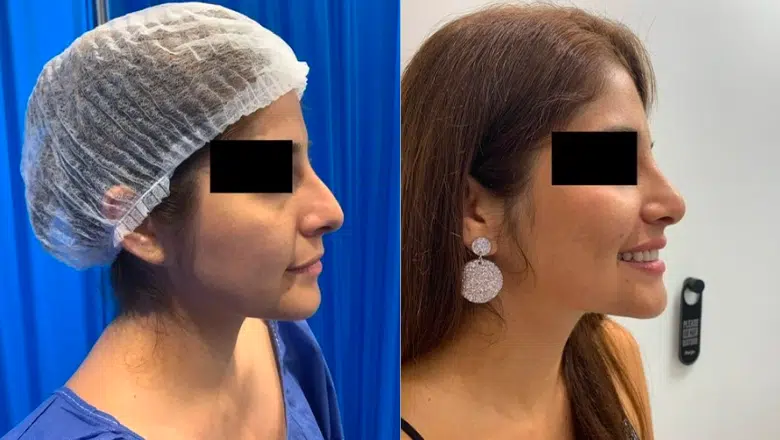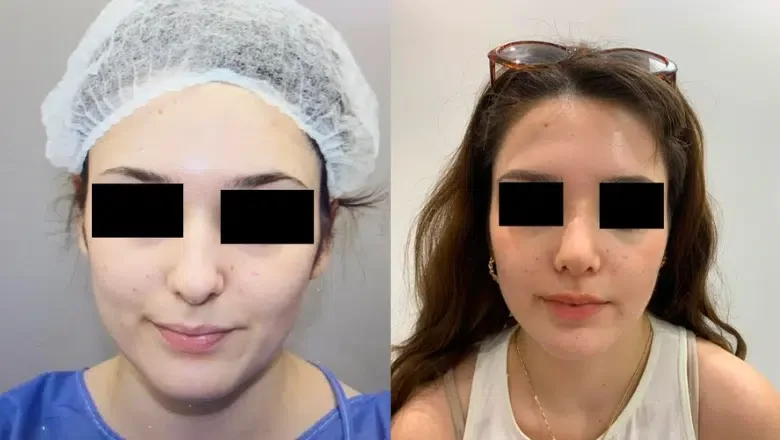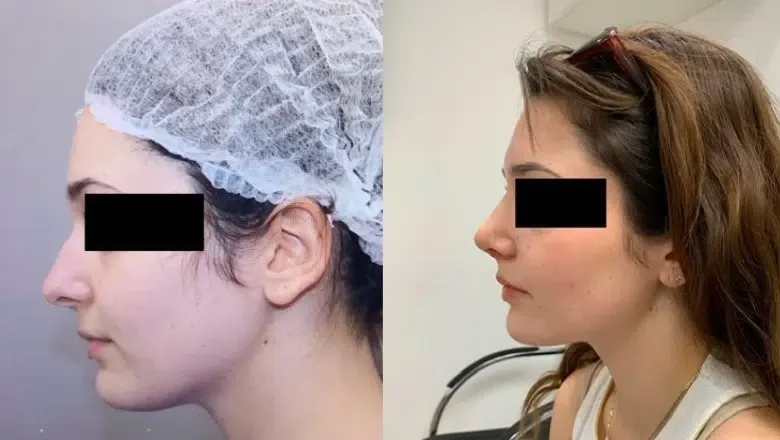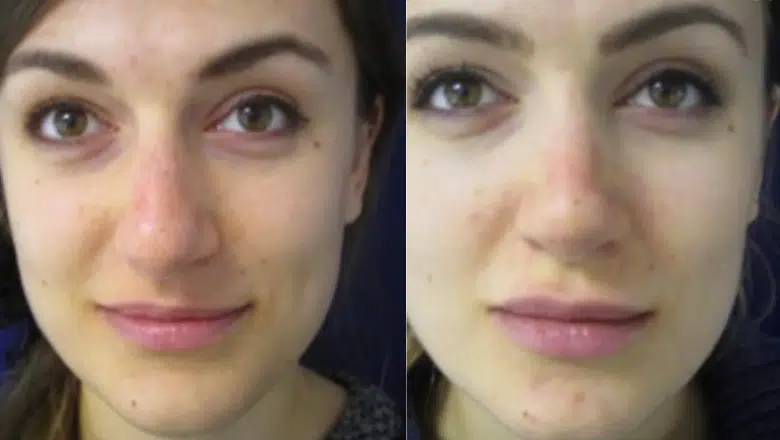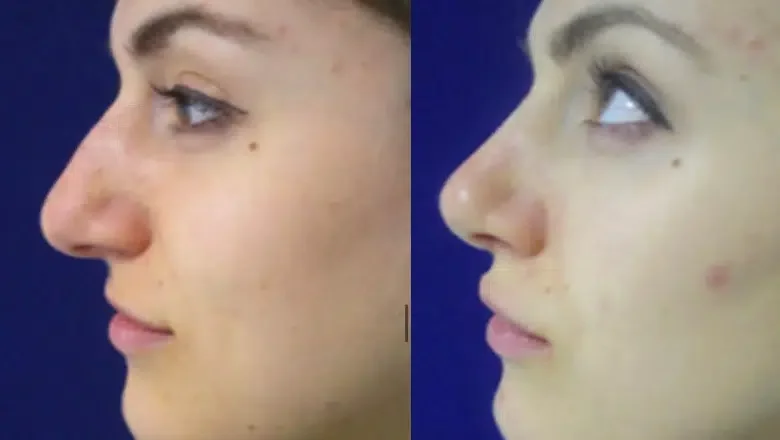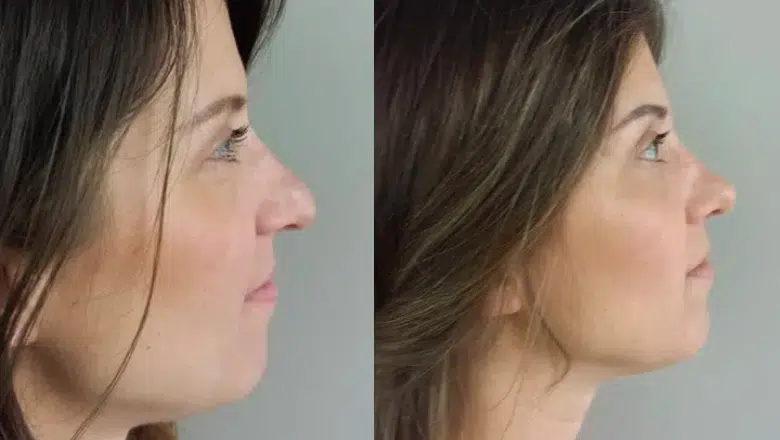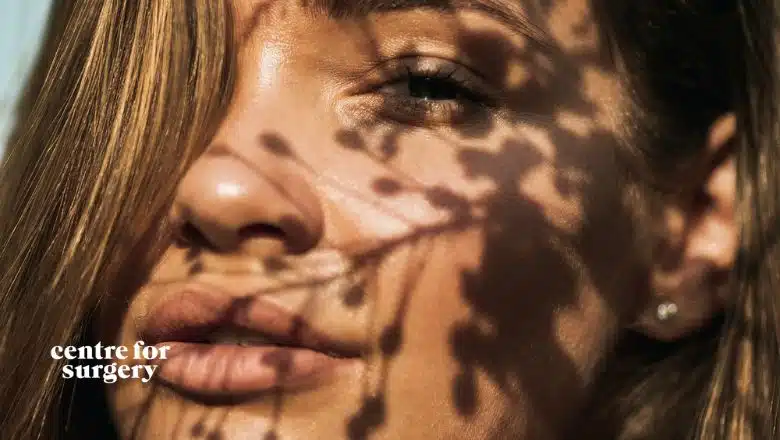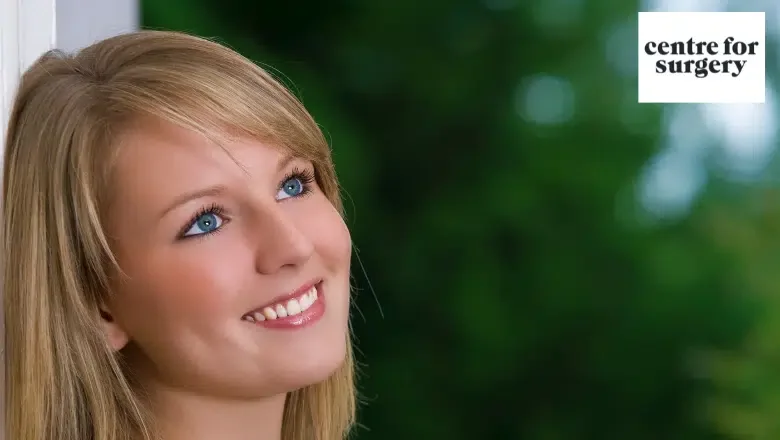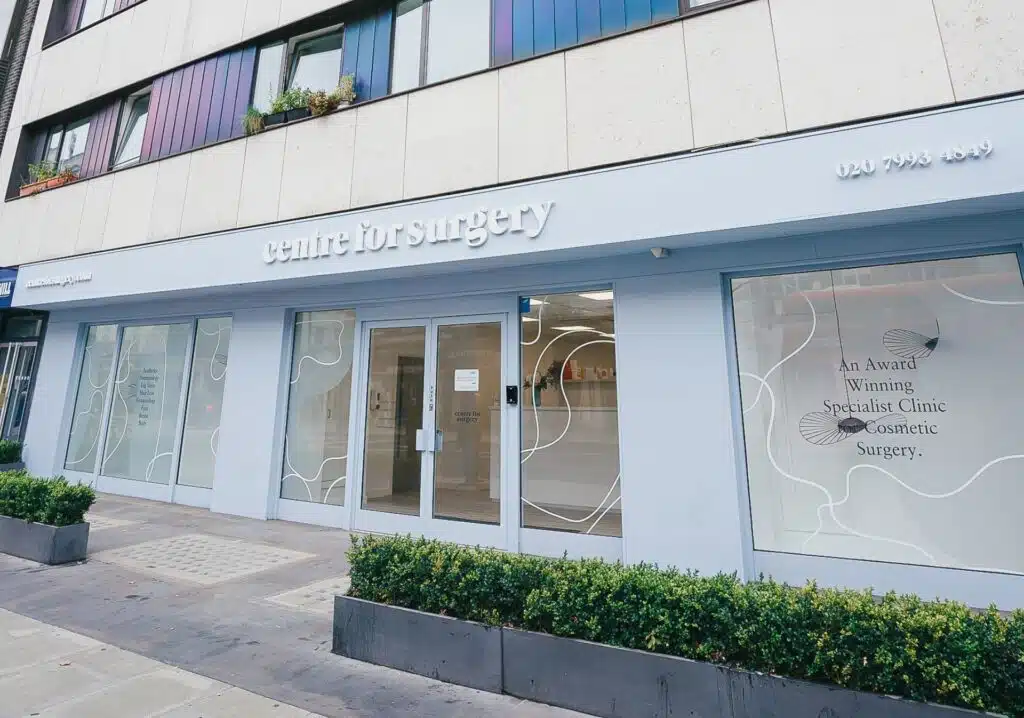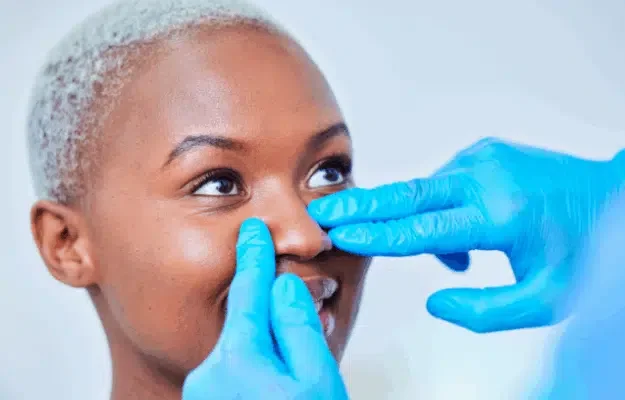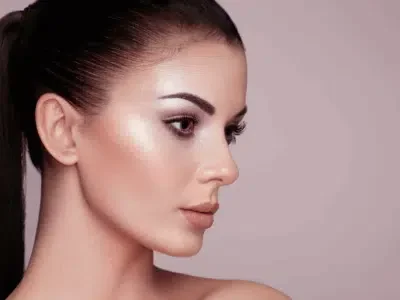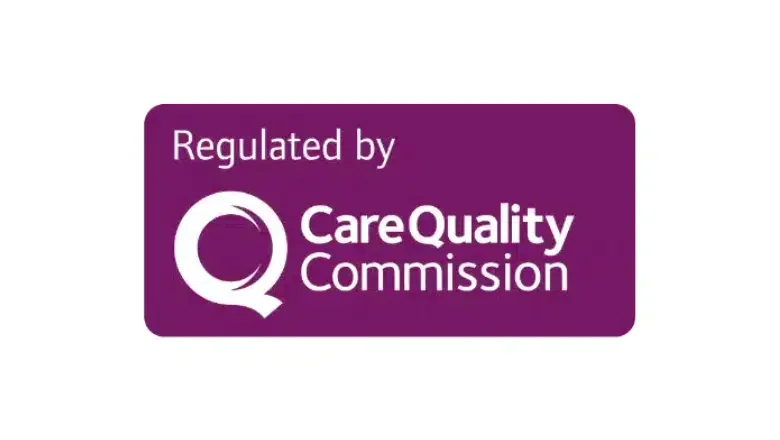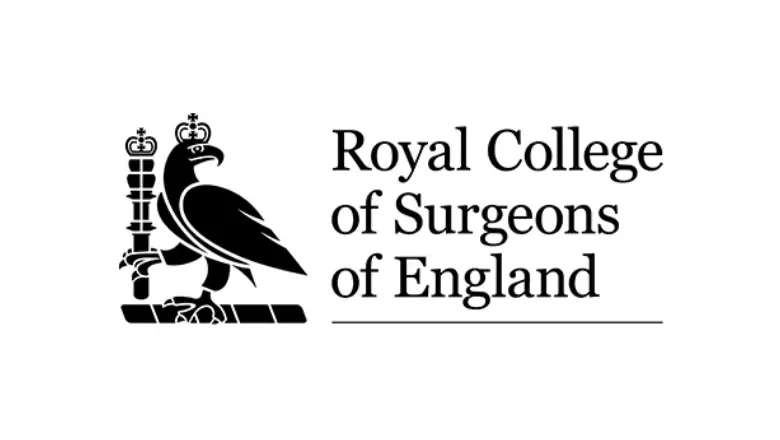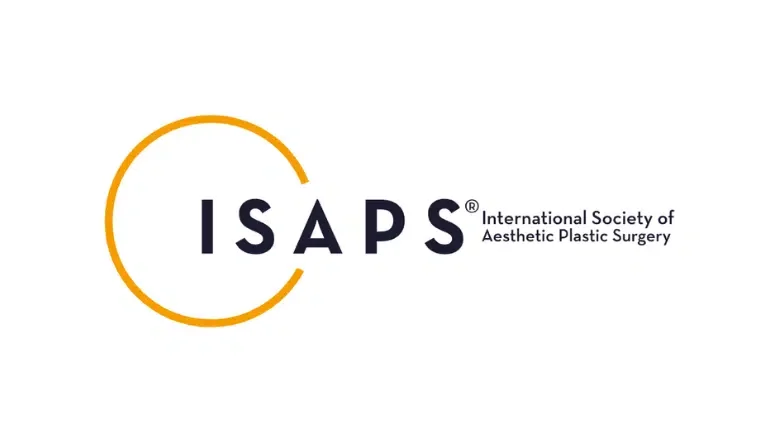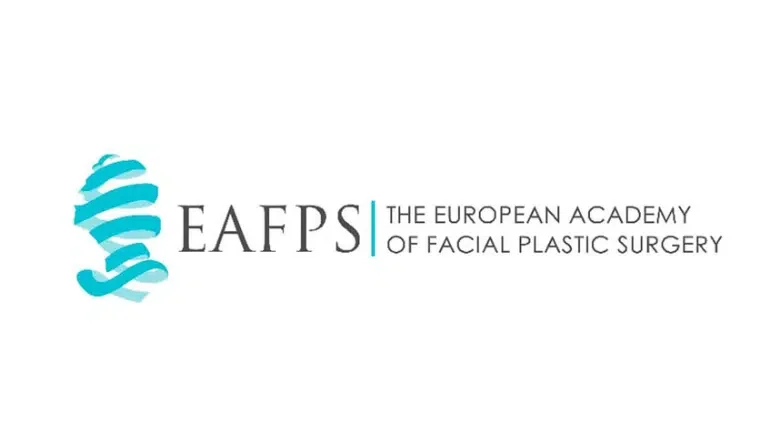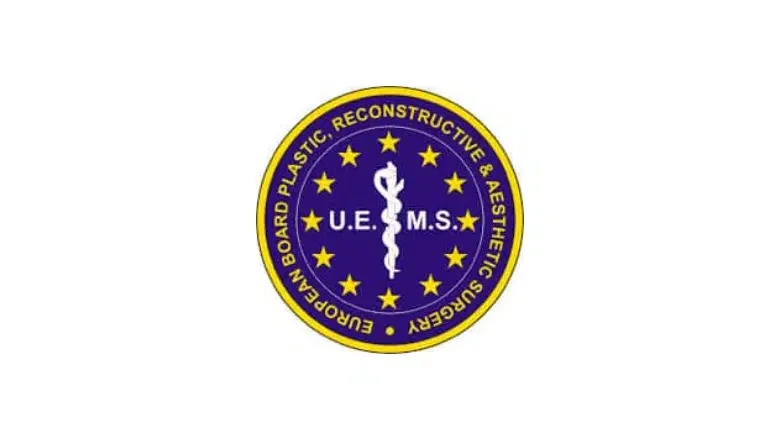Rhinoplasty in London
Transform your look and achieve the nose you’ve always wanted with a personalised nose job tailored to your unique facial features
Rhinoplasty, also known as a “nose job,” is a surgical procedure used to change the shape of the nose. The procedure can correct a wide range of issues, including a bulbous tip, a crooked nose, a hump on the bridge, and nostril asymmetry. It can also be used to improve breathing, reduce the size of the nose, reshape the nose, and improve the overall appearance of the nose.
RELATED: What are the different types of nose shapes?
Although a nose job is most commonly carried out for cosmetic reasons, it can also be used to address functional symptoms, including difficulty breathing through the nose caused by a deviated septum and eliminating loud snoring and sleep apnoea. This is why it is important for a rhinoplasty surgeon to have expertise in nasal reconstruction, as they may be required to operate on the nasal septum and the turbinate bones, which may be responsible for nasal blockage. Septoplasty is the procedure used to correct a deviated septum, which is commonly responsible for airway obstruction.
There are several reasons why patients opt for a rhinoplasty. Many patients may have sustained previous traumatic injuries to the nose due to playing contact sports, and sustaining a nasal fracture. In these cases, private medical insurance coverage may be available; however, you should verify this at the consultation to determine if it is possible. Regardless of the reasons for having the procedure, our treatment philosophy is to aim for natural-looking results in harmony with the rest of your facial features, with a beautifully contoured and sculpted nose that has permanent results. Nose reshaping surgery requires years of skill and dedication to produce consistently good outcomes, as even a couple of millimetres can make the difference between achieving natural-looking results and surgical results that may suggest an ‘overly done’ look. A rhinoplasty is also known as a ‘nose job’. It is one of the most commonly performed cosmetic procedures in the UK, with up to 1 in 10 of all cosmetic surgery procedures involving a rhinoplasty procedure.
What is Rhinoplasty?
View Our Before & After Photos
Browse our rhinoplasty and nose job photo gallery to see the results achieved by our surgeons at Centre for Surgery. The before and after samples of the patient photos we have on file are below. When you come to see us for a consultation, a wide variety will be available. We only show photos of our patients who have given written consent to use their images on our website.
RELATED: Rhinoplasty (Nose Job) before and after photos
Case 1:
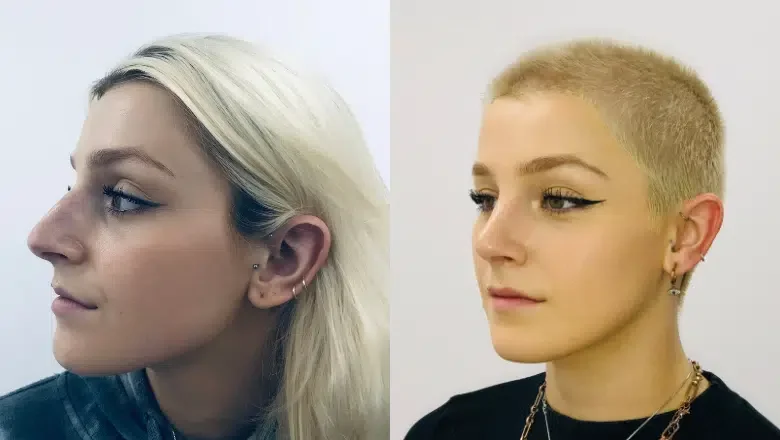
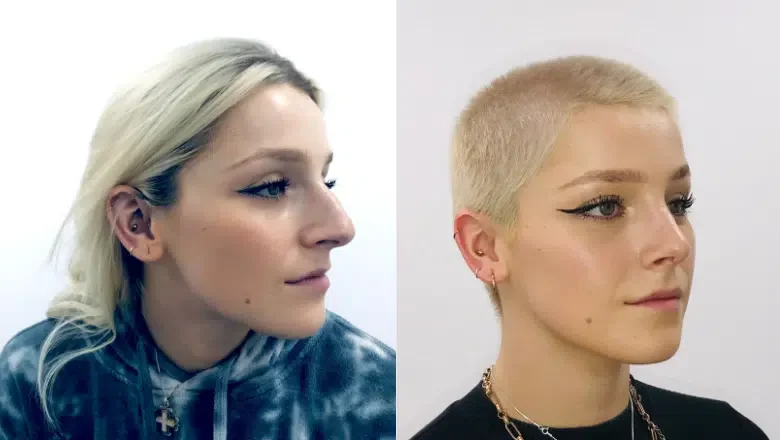
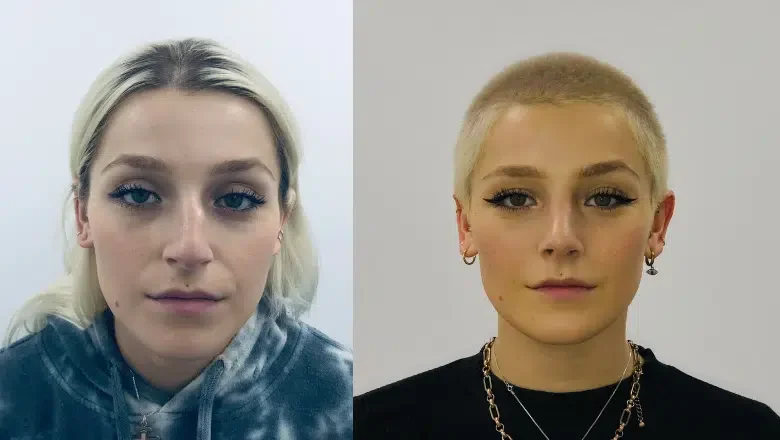
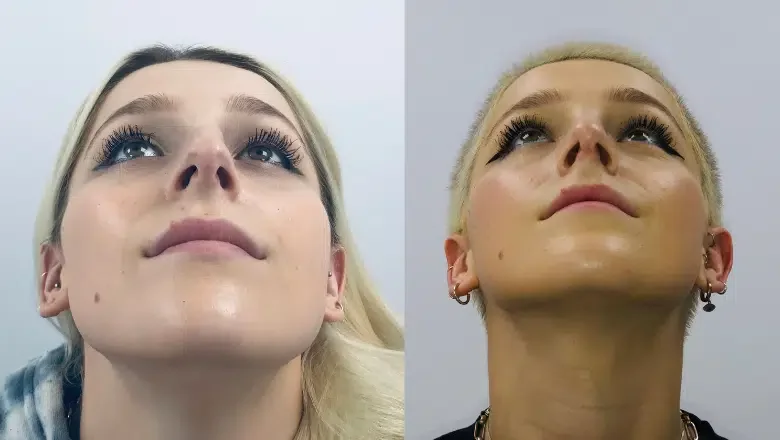
Case 2:
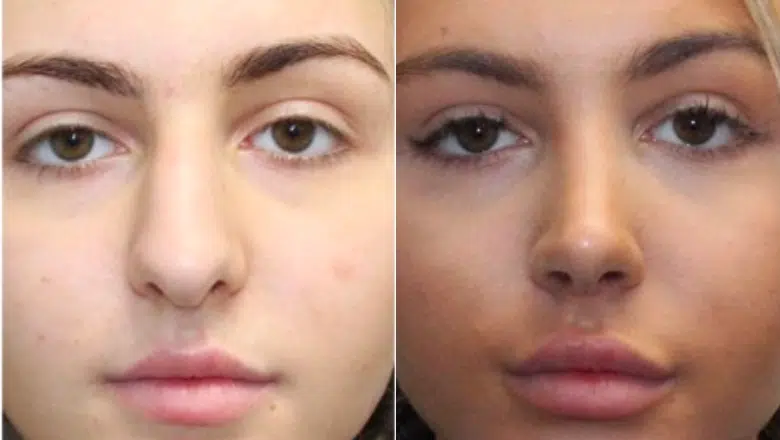
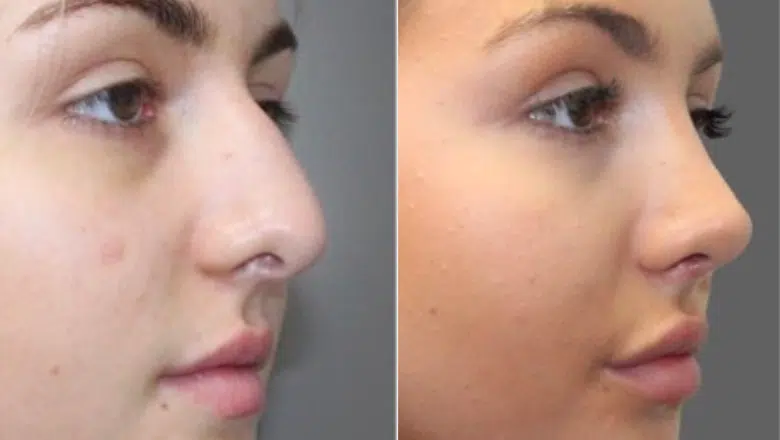
Case 3:
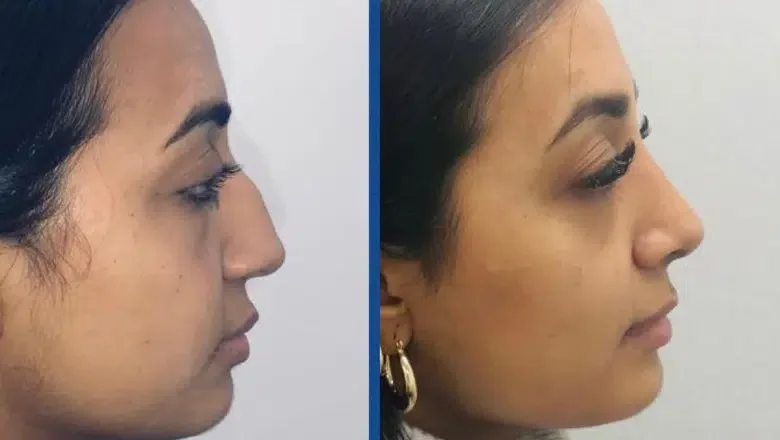
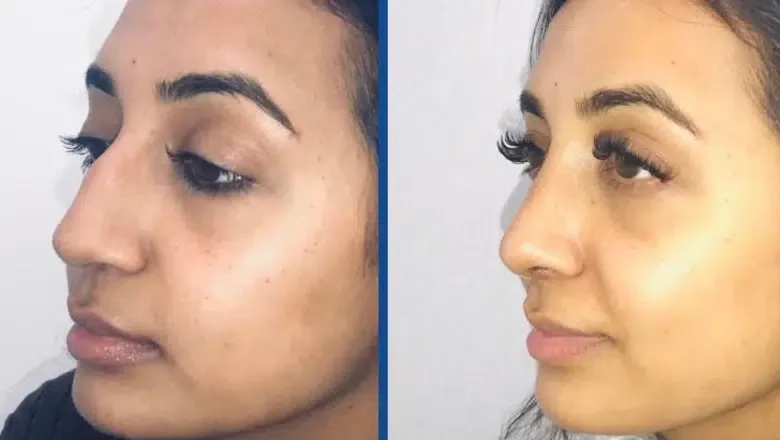
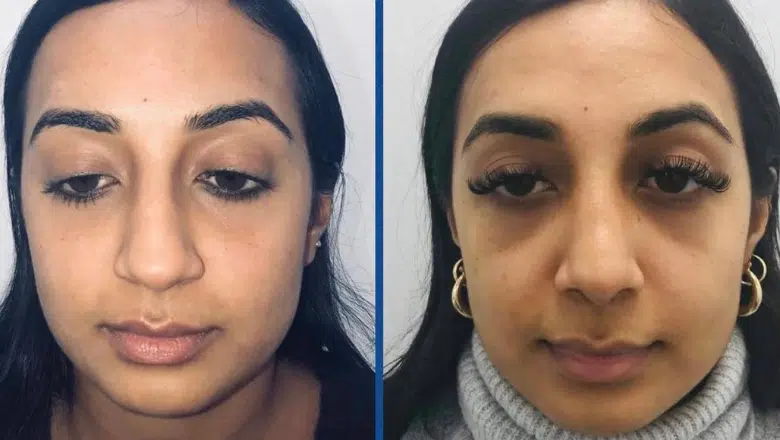
Case 4:
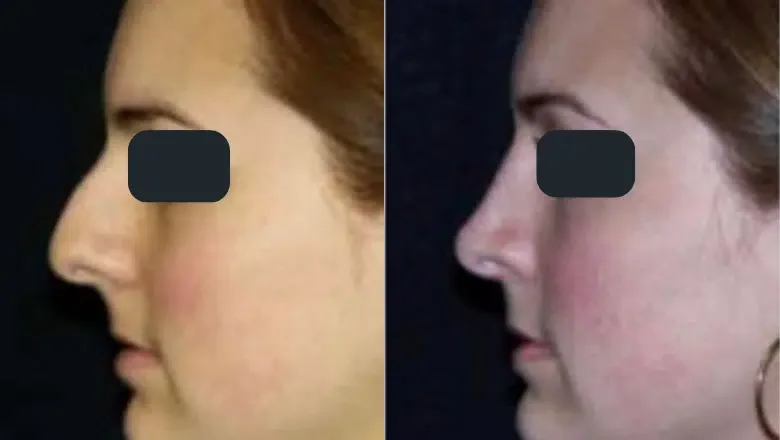
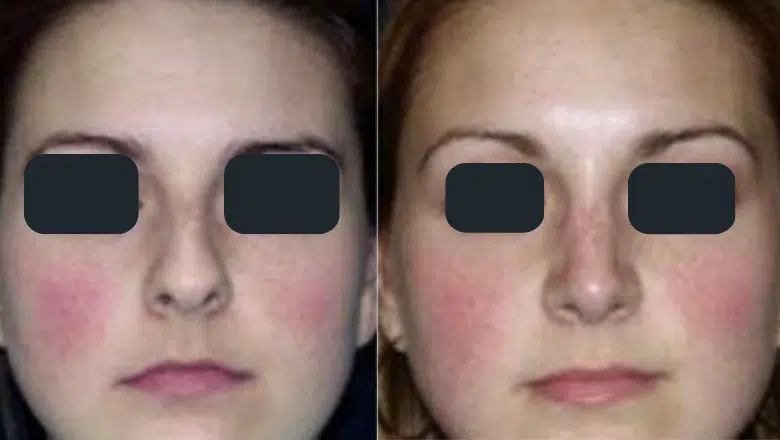
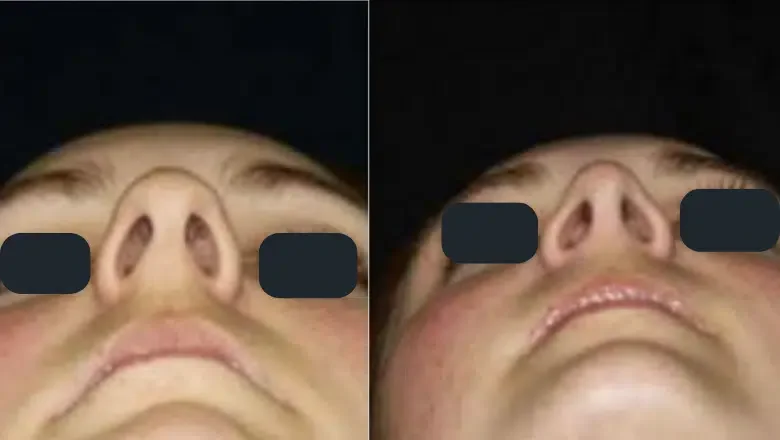
Case 5:
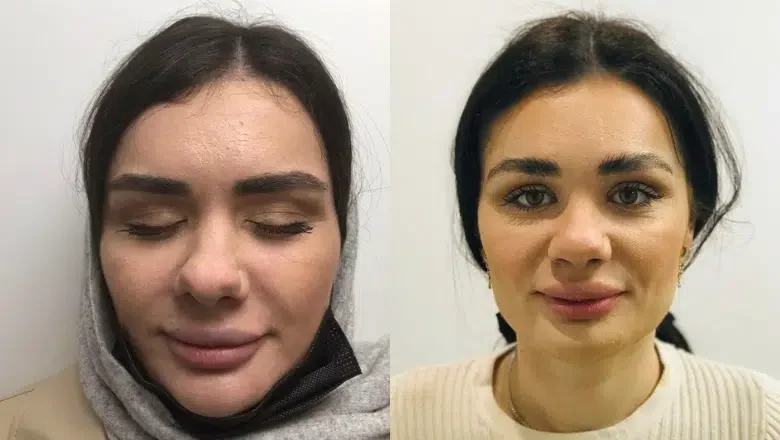
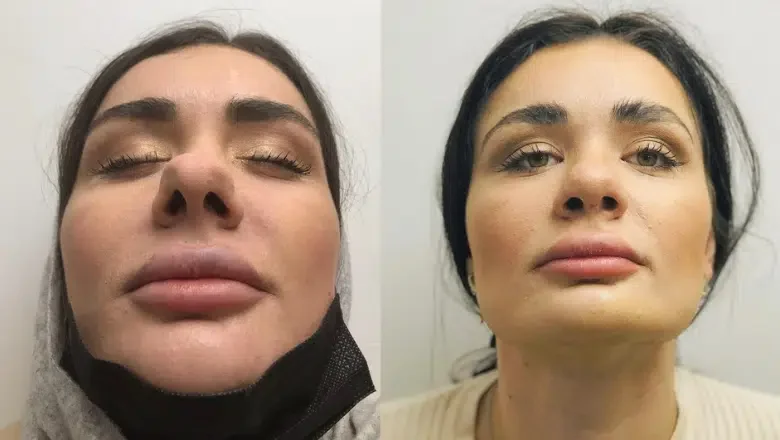
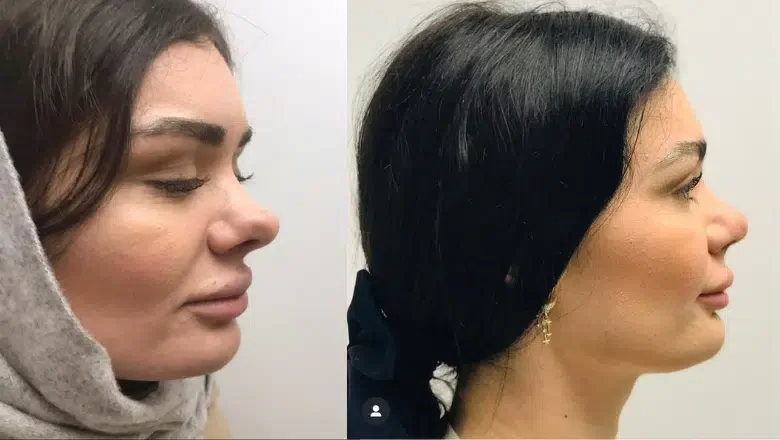
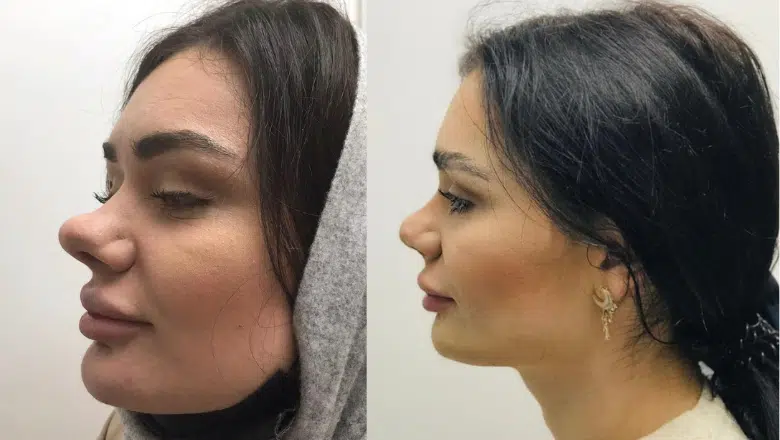
Case 6:
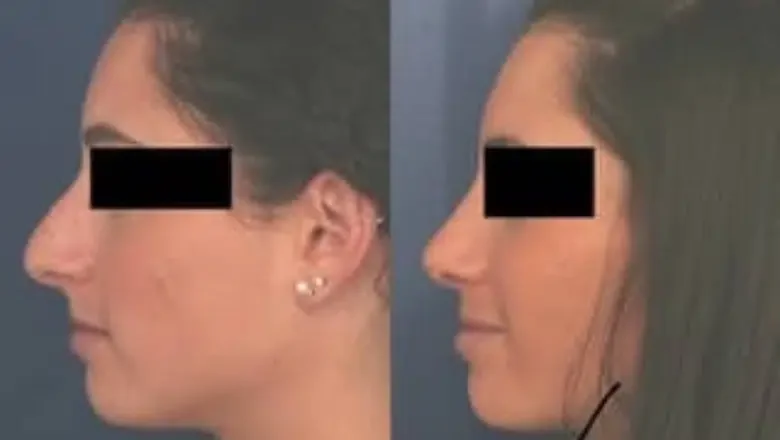
Case 7:
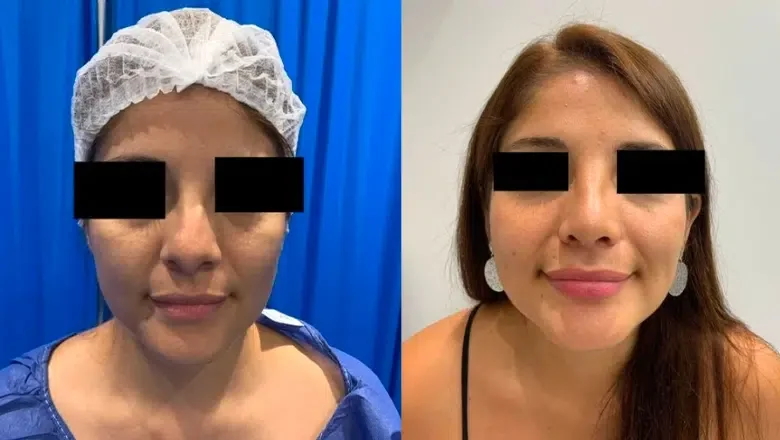
Case 8:
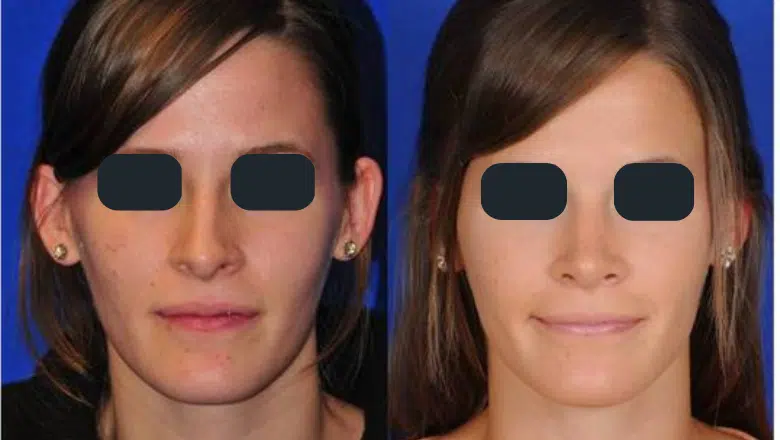
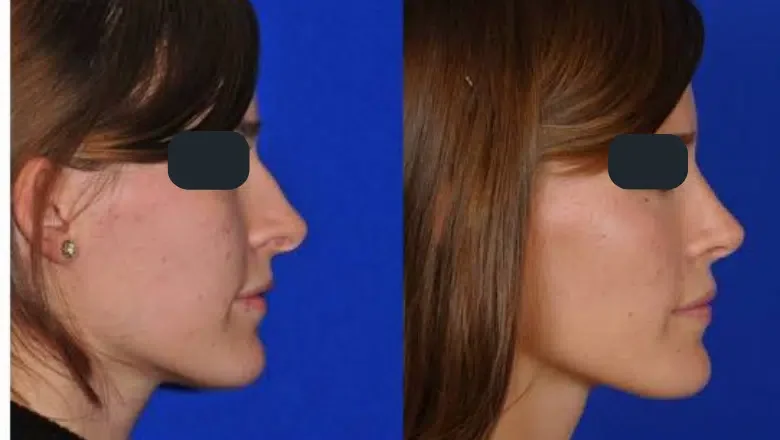
Case 9:
Case 10:
Case 11:
Case 12:
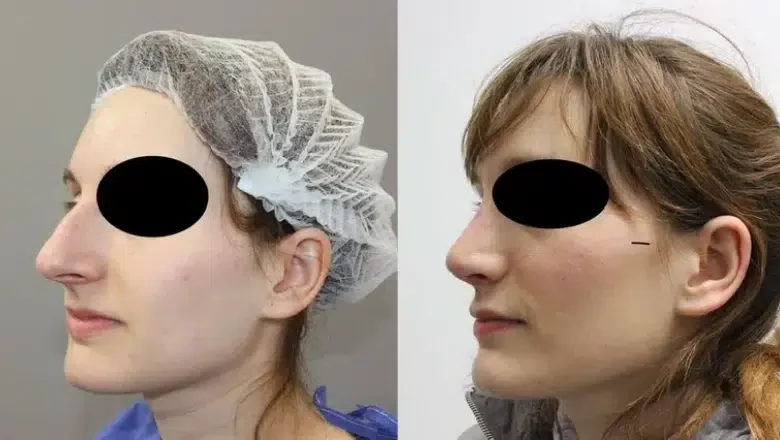
Case 13:
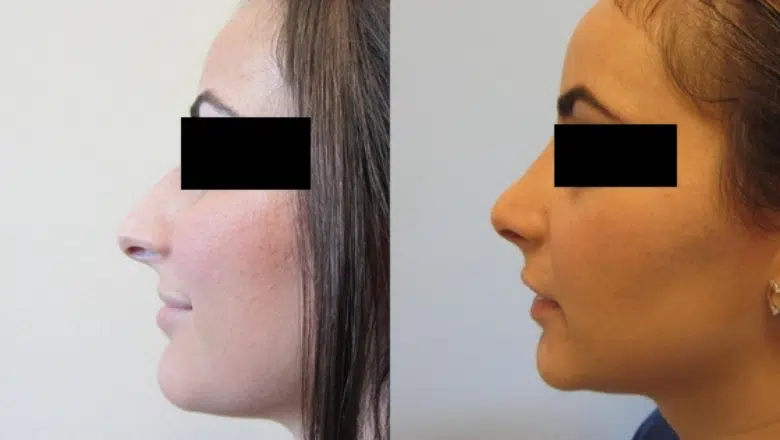
Benefits of a Rhinoplasty
There are several reasons why people choose to have a nose job. Some of the most common reasons include the following:
To correct a congenital defect or injury
Some people are born with a misshapen or structurally flawed nose, while others may have sustained an injury to their nose at some point in their life. Rhinoplasty can be used to correct these issues and improve the appearance and function of the nose.
To improve breathing
Some people may have difficulty breathing through their nose due to structural issues or a deviated septum. Rhinoplasty can be used to correct these problems and improve nasal airflow.
To improve appearance
Many people choose to have a nose job for cosmetic reasons. They may be unhappy with the shape or size of their nose, or may feel that their nose is out of proportion with their other facial features. Rhinoplasty can be used to reshape the nose, reduce its size, or improve its symmetry.
To remove a nasal bump
Some people may have a bump on the nose or a hump on the bridge of the nose, and they may choose to undergo a rhinoplasty to remove it and enhance the overall appearance of their nose.
To reduce the size of the nostrils
Some people may have large nostrils, and they may choose to undergo a rhinoplasty to reduce the size of their nostrils, thereby improving the appearance of their nose.
To correct a deviated septum
A deviated septum can cause difficulty breathing and may be corrected during a rhinoplasty.
What is the success rate of a nose job?
The success rate of a nose job varies depending on the specific procedure and the surgeon’s skill. In general, however, the success rate for rhinoplasty is high, with most patients reporting satisfaction with their results when performed by a specialist rhinoplasty surgeon in London. Complications such as infection, bleeding, and dissatisfaction with the appearance of the nose are relatively rare.
What Conditions Can a Nose Job Target?
Rhinoplasty can be used to correct a wide range of issues, including:
A bulbous tip
A bulbous tip refers to a nose that appears round or rounded at the end. Rhinoplasty can be used to reshape the tip of the nose to make it appear more refined and defined.
A crooked nose
A crooked nose can be caused by a congenital defect or an injury. Rhinoplasty can be used to straighten the nose and improve its overall symmetry.
A hump on the bridge
A congenital defect or an injury can cause a hump on the bridge of the nose. Rhinoplasty can be used to remove the hump and create a more natural and smoother bridge.
Nostril asymmetry
Some people may have nostrils that are different sizes or shapes. Rhinoplasty can be used to correct this asymmetry and improve the overall appearance of the nose.
A deviated septum
A deviated septum refers to a condition in which the cartilage and bone in the nose are not aligned correctly. A deviated septum can cause difficulty breathing and may be corrected during a rhinoplasty.
To reduce the size of the nose
Some people may want to reduce the overall size of their nose to better balance their facial features.
To reshape the nose
Some people may want to reshape their nose to improve its appearance or to bring it into better proportion with the rest of their face.
To improve breathing
Some people may have difficulty breathing through their nose due to structural issues or a deviated septum. Rhinoplasty can be used to correct these problems and improve nasal airflow.
Am I Suitable?
A specialist plastic surgeon typically considers several factors to determine whether or not someone is a good candidate for rhinoplasty surgery.
First and foremost, our surgeon will evaluate your overall health and ensure that you are in good physical condition. This is important because any underlying health issues could increase the risk of complications during or after the nose job surgery.
The surgeon will also consider the specific changes you hope to achieve with the surgery. Rhinoplasty can be used to address a wide range of issues, including a bulbous tip, a crooked nose, a hump on the bridge, and nostril asymmetry. The surgeon will want to ensure that you have realistic expectations for the surgery’s outcome and that the changes you hope to achieve are feasible.
The surgeon will also evaluate your skin type, nasal structure and overall facial balance. In addition to these factors, the surgeon will also discuss the risks and benefits of the surgery with you and explain the recovery process and the potential risks of complications.
Types of Rhinoplasty Procedures
We are home to some of the foremost rhinoplasty experts in the UK with years of experience in carrying out all types of rhinoplasty, including:
Tip plasty
Tip rhinoplasty or tip plasty is designed to address the cartilage part of the nose without any bone work being performed. Rhino-tip surgery can be performed via both an open and closed technique, though it is most commonly performed with the closed rhinoplasty method to reduce visible scarring.
Tip reshaping is ideal for those who do not require dorsal hump removal. Typical examples of patients who need rhino-tip correction include patients with a large boxy tip. Big tips are often rounded, which is often because of thick skin. Bent or crooked tips often lead to the appearance of one nostril looking bigger than the other, which gives rise to nasal asymmetry. Large nostrils can give the appearance of a flattened nose when viewed from the front. Wide nostrils can be addressed with an alar base reduction.
Tip rotation can be an issue, especially when viewed from the side, including over-projected tips, which give the appearance of a hooked nose, and under-rotated tips, which are less common.
Septorhinoplasty
Septorhinoplasty is able to address breathing problems affecting the nose. Septorhinoplasty is commonly performed for patients who have septal deviation. The septum is the midline partition made of both cartilage and bone that divides the nose into two halves. An incision is made in the tissue lining the inside of the nose, known as the mucosa, which is then gently lifted off the septum. The septum is then straightened using a variety of surgical techniques, including spreader grafts.
The straighter septum markedly improves breathing through the nose. In addition to addressing functional problems, the aesthetics of the nose can be enhanced as septorhinoplasty is a two-in-one procedure.
Ethnic Rhinoplasty
Ethnic rhinoplasty is ideal for patients from certain ethnic backgrounds who tend to have broader and flatter noses, often accompanied by enlarged nostrils. Our surgeons employ specialised augmentation rhinoplasty techniques to improve structural support. It is often not appropriate to perform conventional reduction rhinoplasty methods in the ethnic nose.
Cartilage can be harvested from several sites, including the ear or rib. The harvested cartilage is carefully reshaped to fit the recipient site. Alar base reduction is an ideal procedure to reduce the width of the nostrils. In some Far Eastern patients, the inner part of the eyelids is webbed as it blends with the nose. Often, this will also be corrected during the ethnic rhinoplasty.
Preservation rhinoplasty
Preservation rhinoplasty techniques mean surgeons no longer need to break the nose during surgery. The dorsal height can be corrected via an internal access approach to reduce the height sequentially. This incremental approach means the nose will become smaller as the internal height is reduced, and the hump will be removed. The preservation technique takes longer to perform, but the benefits are often well worth the additional time required.
The rhinoplasty procedure has evolved, moving away from destructive cartilage techniques to the preservation of your cartilage and the utilisation of minimally invasive surgical approaches to minimise downtime.
Preservation rhinoplasty can be performed using both open and closed approaches. The key feature in either technique is surgical dissection in the correct plane, which can be tricky if the surgeon lacks experience. Restoration of the soft tissue architecture through the repair of ligaments released to access the nose helps reduce postoperative swelling and leads to a quicker recovery.
Approximately 1 in 5 patients will still require a traditional procedure, and your surgeon can advise you on the most appropriate surgical method.
Revision rhinoplasty
Revision rhinoplasty is designed for individuals who have previously undergone rhinoplasty and now seek to refine or modify the shape of their nose due to dissatisfaction with the initial surgery’s outcome.
The nose consists of both a bony and cartilaginous skeleton. The lower two-thirds are composed of cartilage, and the upper one-third is bony. The cartilage in the lower two-thirds is the same as that found in the ear cartilage. The nose is divided into two halves by a midline cartilage partition called the septum. The septum serves as a structural support for the cartilage portion of the nose, preventing nasal collapse. Most types of rhinoplasty, when performed on Caucasian noses, are for reducing the size of the nose through the reduction of both the bony and cartilaginous portions of the nose.
RELATED: How to make your nose smaller
Open Rhinoplasty vs Closed Rhinoplasty
Open Rhinoplasty
Open rhinoplasty techniques involve making a minimal incision at the columella at the base of the nose between your nostrils. Extra incisions are made inside the nose that are not easily visible. An open rhinoplasty results in complete visualisation of the bony and cartilaginous framework. This permits a more precise correction of the nasal deformity. Open rhinoplasty is ideal for correcting a full range of nose deformities, and certain types of rhinoplasty, such as revision rhinoplasty, are typically performed using an open technique.
Closed Rhinoplasty (endonasal rhinoplasty)
Closed rhinoplasty, also known as endonasal rhinoplasty, involves making incisions inside the nostrils. These incisions are not visible after the procedure. The disadvantage of a closed rhinoplasty includes limited visualisation and increased difficulty in surgically manipulating the nasal structures. Although not as commonly performed as an open procedure, this procedure does have a reduced recovery time and leaves no visible scars.
Differences between female and male rhinoplasty
Rhinoplasty is increasingly popular among both men and women. Despite the universal application of rhinoplasty techniques across genders, there are distinct differences in the surgical objectives and expectations between male and female patients. These differences are not just rooted in anatomical variances but also in the unique aesthetic goals each gender typically seeks through rhinoplasty.
Male Rhinoplasty
For male patients, rhinoplasty often focuses on enhancing the nasal structure to create a more pronounced, straighter angle and a defined profile. The goal is to achieve a more rugged and distinguished look, with attention to maintaining or introducing angularity that signifies strength and masculinity. Men opting for rhinoplasty might also aim to correct deformities or asymmetries resulting from injuries, particularly those related to sports, ensuring the nose complements other facial features without dominating the face.
Female Rhinoplasty
Conversely, female rhinoplasty typically aims for a gentler enhancement, favouring a refined and delicate outcome. This often involves narrowing the bridge, reducing a dorsal hump, and slightly elevating the tip to create a graceful, aesthetically pleasing profile. These subtle changes can significantly impact overall facial harmony, softening and feminising the appearance. It’s noteworthy, however, that the flexibility of rhinoplasty allows for incorporating traditionally masculine traits into female rhinoplasty and vice versa, catering to the diverse preferences and identities of all patients.
Anatomical Considerations and Additional Procedures
Anatomically, men’s noses tend to be larger with a thicker skin layer, which can lead to a bulbous appearance, especially in the tip. This characteristic is more pronounced with age and can be exacerbated by certain skin conditions, such as Rosacea, particularly in men between 50 and 70. Addressing this requires precise surgical techniques to refine the tip while considering the skin’s characteristics for a natural, balanced outcome.
Male rhinoplasty is often complemented with other procedures, like chin augmentation, to enhance the masculine appeal by improving facial proportions and symmetry, further accentuating a strong, masculine jawline alongside the reshaped nose.
Preparation for Surgery
Preparing for rhinoplasty involves several important steps to ensure that the surgery goes smoothly and that the patient can recover as quickly and comfortably as possible.
Here are some of the key steps that patients should take to prepare for rhinoplasty:
Medical assessment
Patients will need to undergo a medical assessment to ensure they are in good health and can undergo the surgery safely. The surgeon will review the patient’s medical history, perform a physical examination, and may order some lab tests if necessary.
Stop smoking and avoid certain medications
Smoking can interfere with the healing process, so patients should stop smoking at least six weeks before the surgery. Patients should also avoid certain medications, such as aspirin and non-steroidal anti-inflammatory drugs (NSAIDs), as they can increase the risk of bleeding.
Make arrangements for postoperative care
Patients should make arrangements for post-operative care, such as arranging for someone to drive them home after surgery and having someone stay with them for the first few days to assist with tasks like bathing and dressing.
Follow preoperative instructions
The surgeon will provide you with detailed preoperative instructions, including information on what to eat and drink before surgery, how to prepare for the procedure, and how to care for the surgical site afterwards. You will need to follow these instructions carefully to ensure a smooth recovery.
Understand the recovery process
The rhinoplasty recovery process can take several weeks, so it is essential for the patient to understand what to expect during this time and plan accordingly. Some swelling and bruising are expected after the surgery, and the patient will need to avoid certain activities, such as sports, heavy lifting, and exercise, for at least two weeks.
Have realistic expectations
You should have realistic expectations for the outcome of the surgery and understand that the final results will not be visible until the swelling has completely subsided.
Surgical Procedure
Rhinoplasty typically takes 1-3 hours to perform. However, the recovery time can vary depending on the individual and the complexity of the procedure.
Rhinoplasty surgery step by step
Anesthesia
Rhinoplasty is typically performed under general anaesthesia.
Incision
The surgeon will make incisions inside the nostrils or across the columella (the area between the nostrils) to access the underlying bone and cartilage.
Reshaping the Bones
Depending on the desired outcome, the surgeon may use surgical tools to reshape the nasal bones. This may involve breaking the nose and resetting it to a new position or using small grafts to add or remove bone.
Reshaping the Cartilage
The surgeon may also reshape the cartilage, which provides structure and support to the nose. This may involve removing or repositioning cartilage or using grafts to augment cartilage in specific areas.
Closing the Incisions
The surgeon will then close the incisions using sutures or surgical tape.
Placement of Splint
A splint is placed on the outside of the nose to help maintain the new shape of the nose and to protect it during the healing process.
Will my nose need to be fractured during a rhinoplasty?
During a rhinoplasty, also known as a “nose job,” the nose may or may not be fractured, depending on the specific goals of the surgery and the individual case.
In some cases, the surgeon may choose to use an “open” technique, which involves making an incision on the columella (the small strip of tissue that separates the nostrils) to access the nasal bones and cartilage. In these cases, the surgeon may need to fracture the nasal bones to reshape them and achieve the desired outcome.
In other cases, the surgeon may opt for a “closed” technique, which involves making incisions within the nostrils to access the nasal bones and cartilage. In these cases, it may not be necessary to fracture the nasal bones.
Recovery after Rhinoplasty: What to Expect
Recovery after rhinoplasty can vary depending on the specific procedure performed, the patient’s overall health, and the patient’s individual healing process.
The patient’s nose will be swollen and bruised immediately after the surgery. The surgeon will place a splint on the nose to help support it during the healing process. The patient will also have to wear a nasal dressing, which will be removed after a week.
RELATED: How To Reduce Bruising And Swelling After A Nose Job
During the first few days, the patient will experience some pain and discomfort, which can be managed with pain medication prescribed by the surgeon. Cold compresses can be applied to the nose to help reduce swelling and bruising. The patient should also rest with their head elevated to help reduce swelling.
The patient can return to work or school within one week, but strenuous activities, such as sports, heavy lifting, and exercise, should be avoided for at least two weeks. The patient should also avoid activities that could cause injury to the nose, such as contact sports or activities that expose the face to direct sunlight.
Swelling and bruising will gradually improve over the first few weeks, but some residual swelling may persist for up to 3 months. The final results of the surgery will not be visible until the swelling has completely subsided.
The patient will need to follow the surgeon’s instructions for post-operative care and attend follow-up appointments to ensure that the healing process is progressing as expected. The patient should also be aware that there may be some slight asymmetry and irregularity after the surgery, but these issues can usually be corrected with revision surgery if necessary.
Recovery after rhinoplasty can vary significantly from person to person, and some individuals may experience more or less swelling, pain, and other side effects than others.
RELATED: How long does it take to recover from nose job surgery?
What are the alternatives to a rhinoplasty?
Non-Surgical Rhinoplasty ‘liquid nose job’
For patients who desire only subtle changes to the nose and are not keen on the idea of invasive surgery, the option of non-surgical rhinoplasty is now available for temporary correction of nasal imperfections. In non-surgical rhinoplasty, hyaluronic acid-based soft tissue fillers are injected to reshape the nasal framework. Non-surgical rhinoplasty should be viewed as a medium-term solution, as the fillers have a thicker consistency and therefore last up to a year. Hyaluronic acid fillers gradually break down, making the procedure a temporary solution. The non-surgical nose job procedure is commonly used as a ‘tester’; patients can gauge how they look with the non-surgical rhinoplasty first. If they are satisfied, then they can proceed with a more permanent long-term solution, such as surgical rhinoplasty. Patients who are not keen on the idea of surgery can opt for yearly maintenance treatments. It should be noted that non-surgical rhinoplasty can not correct all abnormalities of the nasal structure, unlike a surgical rhinoplasty and is ideally suited for the correction of the nasal bridge or tip.
How Much Does a Rhinoplasty Cost?
When considering rhinoplasty in London, it’s crucial to recognise that various factors influence the cost. The individual nature of each surgery means that a fixed price isn’t usually available upfront. Here’s a breakdown of how it works:
Personalised Costing
The cost of your rhinoplasty will be unique to your needs. It isn’t a one-size-fits-all price tag. Factors like the surgical technique used, the complexity of changes, and the duration of the surgery all play a role.
Initial Consultation
This is your opportunity to discuss your goals, concerns, and get a clearer understanding of the procedure. The surgeon will evaluate your facial structure, the anatomy of your nose, and any medical considerations. Based on this assessment, you will be given a precise cost estimate for the procedure.
Different Fee Structures
Remember, the total cost of the surgery includes not only the price of the surgical procedure itself, but also any additional expenses. It will encompass the surgeon’s fee, the anaesthetist’s fee, facility-related charges, and any post-operative care.
Surgical Technique and Cost
Rhinoplasty can be performed using different techniques. The ‘closed’ technique involves incisions made within the nostrils, while the ‘open’ method involves an additional small incision on the base of the nose. Depending on the technique your surgeon recommends, the cost might differ.
Insurance Considerations
If your rhinoplasty is being done for medical reasons, such as to address breathing difficulties following an injury, you might be eligible for insurance coverage. This can offset a portion of the costs. It’s important to check with your insurance provider about what’s covered and the criteria for eligibility.
Why not call 0207 993 4849 and speak to one of our expert patient coordinators, who may be able to give you a rough costing before your procedure?
Spread the cost of your rhinoplasty procedure – from as little as £120 per month
Centre for Surgery is fully approved to offer finance via our specialist finance partner, Chrysalis Finance. You no longer need to use your savings to pay for your treatment – you can apply to spread the cost of your procedure with Chrysalis Finance using their simple 1,2,3 application to pay for it. Don’t wait until you have enough money for your treatment. Apply today and (subject to status) pay for your procedure easily in monthly instalments using one of their payment options. Chrysalis Finance is the only ethical provider that focuses solely on the provision of specialist financing for medical procedures.
What is included in my treatment package?
- As many preoperative consultations with your surgeon as you like to make sure the procedure is right for you
- Treatment at a specialist day surgery facility recently rated ‘Good’ by the CQC
- Enhanced same-day discharge with the added benefits of recovering in your own home
- 24/7 clinical support from your surgeon for the first 48 hours and our expert postoperative support team
- Your very own dedicated patient coordinator
- In-depth preoperative medical assessment to make sure you are fully fit for the rhinoplasty procedure
- Exceptionally high standards of postoperative care described as ‘outstanding’ by the CQC with regular telephone and face-to-face checks by our expert postoperative support team.
Why Should You Choose A Specialist Rhinoplasty Surgeon?
Choosing a specialist rhinoplasty surgeon is important for several reasons. Here are some of the key reasons why it’s important to choose a specialist rhinoplasty surgeon:
Experience and expertise
A specialist rhinoplasty surgeon will have extensive experience and expertise in performing the nose job procedure. They will have a deep understanding of the anatomy of the nose and the different techniques that can be used to achieve the desired results. They will also have a portfolio of before-and-after photos to show the potential outcomes of the surgery.
RELATED: How to Choose The Best Nose Surgeon London
Safety and quality of care
A specialist rhinoplasty surgeon will be able to provide the highest level of safety and quality of care. They will have the necessary equipment, facilities and staff to ensure the best outcome and minimise the risks associated with the surgery.
Understanding of facial aesthetics
A specialist rhinoplasty surgeon will deeply understand facial aesthetics and the principles of balance and proportion. They can help the patient achieve the desired outcome while maintaining overall facial harmony.
Patient-centred approach
A specialist rhinoplasty surgeon will take a patient-centred approach and will be able to understand the patient’s specific needs and concerns. They will work with the patient to develop a treatment plan that addresses those needs and achieves the desired outcome.
Postoperative care
A specialist rhinoplasty surgeon will provide the patient with detailed post-operative instructions and will be available for follow-up visits to ensure that the healing process is progressing as expected. They will also be able to address any concerns or complications that may arise during the recovery period.
Revision surgeries
A specialist rhinoplasty surgeon will have experience in performing revision surgeries and will be able to address any issues that may arise after the initial surgery. They can evaluate the patient’s individual case and recommend the appropriate revision procedure to achieve the desired outcome.
GMC specialist register
A specialist rhinoplasty surgeon will be on the GMC specialist register in the relevant surgical speciality and will have completed extensive training and education in plastic surgery. This ensures that they have met certain standards of training and expertise and are up-to-date with the latest advancements in their field.
Reviews and referrals
A specialist rhinoplasty surgeon will have reviews and referrals from previous patients who have undergone the procedure with them, which can give potential patients an idea of their experience and level of satisfaction.
RELATED: Best Rhinoplasty Surgeon UK
RealSelf Top Doctors
RealSelf’s top doctor status is awarded to less than 10% of the RealSelf doctor community. This status is earned by achieving consistently high patient satisfaction (from RealSelf reviews), getting excellent feedback on expert answers to patient questions, and investing significant time in Q&A and other doctor activities.
Why Choose Centre for Surgery?
FAQs
-
What is rhinoplasty surgery?Rhinoplasty surgery alters the size and shape of the nose and can be performed for aesthetic, reconstructive or combined and aesthetic and reconstructive reasons.
There are different types of nose shapes, with some of the most common types which can be treated with Rhinoplasty including:
- Long noses with prominent nasal tips or large nostrils
- Large noses with prominent nasal tips or large nostrils
- Nasal asymmetry or asymmetrical nostrils
- Prominent bump on the bridge of the nose
- Deviated septum causing airway obstruction and breathing difficulty
The nose forms a central component of the face and therefore has a significant impact on the overall facial balance. Nose contouring surgery is highly effective in correcting many nasal abnormalities, including crooked noses, bulbous noses and hooked noses. -
What are the different types of nose surgery?There are a number of different types of rhinoplasty - the main difference is between an open and closed rhinoplasty.
Closed rhinoplasty (endonasal rhinoplasty) is a common type of nose surgery procedure. There are no external incisions made in a closed rhinoplasty, and all incisions are made inside the nostrils to expose the structures to be modified. Both bony and cartilaginous structures can be modified, and tip work is also possible with a closed approach. A closed nose job results in less bruising and swelling, leading to a faster recovery. The operation is also much quicker compared with an open rhinoplasty.
Open rhinoplasty surgery results in full exposure of the underlying bony and cartilaginous framework. Under direct vision, the surgeon is able to correct with precision any nasal structure. The incision for open rhinoplasty is made at the columella, which is the area of skin between the nostrils. This heals very well and is barely visible three months after the procedure. The skin is carefully reflected from the underlying tissues to facilitate the subsequent nose reshaping. After the procedure, the special brown tape is applied to the nose, followed by the application of an aluminium-backed nasal splint. This is kept in place for one week to protect the bone during healing. An open rhinoplasty technique is also the foundation for an ultrasonic rhinoplasty technique. the open approach is ideal for patients with significant structural issues or previous traumatic injury to the nose and also for revision rhinoplasty.
Septorhinoplasty is performed for patients with functional impairments to the nose, of which the most common is difficulty in breathing. This is often due to a deviated septum which is the midline partition between the two nostrils. The septum is also composed of cartilage in its front portion, and this can be straightened as well as used as a source of grafting material for augmenting other parts of the nose. A septorhinoplasty can address both functional and aesthetic concerns in a single procedure. The procedure takes longer to perform compared with a traditional open rhinoplasty.
Tip rhinoplasty is performed to modify the cartilaginous part of the nose, which is the lower two-thirds. The nasal alterations can be made as part of closed or open rhinoplasty. A closed approach may not work for all deformities as visualisation is limited in the closed approach. An open approach can be used for all modifications. Common tip abnormalities include an over-rotated or under-rotated tip, large flared nostrils, or tip under-projection or over-projection.
Non-surgical rhinoplasty is a non-invasive type of nose reshaping that does not involve surgery. A soft tissue filler called hyaluronic acid is injected into the nose to correct minor abnormalities. Rhinofiller is ideal for patients who are not keen on surgical rhinoplasty and prefer only subtle changes to the nose. The effects are temporary in nature and will need repeat injections if you wish to maintain the results from your previous treatment. Often patients will use a non-surgical rhinoplasty as a ‘tester’ to determine if they would like the results from a surgical nose job. They can then proceed to the surgical procedure with a more accurate idea of what it could look like. -
What does the rhinoplasty procedure involve?A closed rhinoplasty or open rhinoplasty can be performed. Open rhinoplasty is better for correcting tip deformities and revision rhinoplasty surgery. The closed rhinoplasty technique is better for correcting hump deformities, and the healing is generally quicker.
In a nose reduction procedure, the nose is surgically made smaller with the removal of cartilage and bone. The surgeon can do this by either using a rasp to file down the dorsum of the nose or, for larger dorsal humps, an osteotome. If the nose in the upper third needs to be narrowed, lateral osteotomies must also be performed. Towards the end of the procedure, your surgeon will decide whether to narrow the nostrils to maintain balance with the rest of the newly reduced nose. Tip rhinoplasty involves the use of both suture techniques and cartilage grafting techniques to control the rotation and projection of the nose. The angle between the nose and upper lip can also be modified. -
Do All Plastic Surgeons Perform Rhinoplasty?Not all plastic surgeons are capable of performing rhinoplasty. It's vital to select a surgeon with specific experience and expertise in rhinoplasty to achieve the best results. Their specialised knowledge and skills in reshaping the nasal structure can significantly impact the surgery's success and your satisfaction with the outcome.
-
What can be achieved with rhinoplasty?The Rhinoplasty procedure can achieve the following objectives:
Narrow the bridge or middle third of the nose
Reshape the nostrils by widening or narrowing
Nose tip reshaping and refinement
Sculpt the bridge or nasal dorsum of the nose
Reducing the size of the nose with the removal of cartilage and bone
Nasal profile contouring
Functional objectives:
Rhinoplasty for noses previously damaged through trauma (car accidents, sports etc.)
Septum deviation or a bent nose
Breathing difficulties -
Can Rhinoplasty Make My Nose Smaller?Yes, rhinoplasty can be used to reduce the size of your nose. It can adjust the bone, cartilage, and soft tissues to achieve a smaller, more proportionate nose that complements your facial features. This procedure is customised to meet the individual's aesthetic goals.
-
Who Is an Ideal Candidate for a Nose Job?To qualify for rhinoplasty, several criteria should be met to ensure the best outcomes. Firstly, your facial growth must be complete, which typically means you're over the age of 18. Physical health is paramount; being in good health without chronic illnesses facilitates a smoother recovery process. Realistic expectations are crucial; understanding what rhinoplasty can and cannot achieve helps in achieving satisfaction with the results. Finally, non-smokers are ideal candidates, or those who can abstain from smoking for a specified period before and after the surgery, as smoking can hinder the healing process.
-
What is preservation rhinoplasty?With rhinoplasty performed in those of Caucasian origin, the main problem reported by patients is a prominent dorsal hump independent of age or gender. The removal of the dorsal hump in a procedure known as dorsal hump reduction is a key component of a rhinoplasty procedure with the removal of controlled amounts of bone and cartilage. In traditional rhinoplasty surgery, dorsal hump reduction leads to disruption of the bony vault of the nose, and additional steps are necessary to restore the nasal anatomy and function. For many years, dorsal hump reduction was the standard procedure used by most rhinoplasty surgeons to alter the nasal shape. There are a number of complications associated with bony hump reduction, including irregularity of the underlying bone, deformity and a saddle nose from the removal of too much cartilage. Of all plastic surgery procedures, rhinoplasty carries a significant rate of revision surgery when compared with other facial and body procedures. This is often because it can be very difficult to predict how the nose will heal after surgery. In revision rhinoplasty, the use of grafts taken from other parts of the body may be required to reconstruct the nasal framework. In preservation rhinoplasty, the surgeon is able to employ gentler techniques to reshape the nasal bone. There is no longer a need to perform potentially aggressive manoeuvres with traditional surgery. Preservation rhinoplasty is gentler on the soft tissues and results in less bruising and swelling in the postoperative period. The results can also look more natural with the avoidance of the risks of a dorsal hump reduction using older methods. The rate of revision surgery is lower following preservation rhinoplasty. The recovery is much quicker and is comfortably performed as a day case procedure, meaning you get to recovery in the comfort of your own home following surgery. Bleeding is much less, and this results in less bruising. The older method of inserting nasal packs into the nose may not be required after the procedure. These packs can be uncomfortable to remove in many cases. Patients can breath through their nose and regain their sense of smell much quicker. To learn more about preservation rhinoplasty and if it could be appropriate for you, please book a consultation with one of our specialist rhinoplasty surgeons.
-
What are the anaesthesia options for rhinoplasty surgery?Patients will be given anaesthesia in order to make them comfortable and pain-free during the procedure. There are several different options for anaesthesia that can be used during rhinoplasty, and the best option will depend on the patient's individual needs and preferences.
Here are some of the most common options for anaesthesia used during rhinoplasty:
Local anaesthesia: Local anaesthesia is the injection of a numbing agent directly into the surgical site. This type of anaesthesia is used for minor procedures that do not require the patient to be completely asleep. Local anaesthesia is usually combined with IV sedation, which is a mild form of anaesthesia that relaxes the patient and makes them drowsy.
IV sedation: IV sedation is a mild form of anaesthesia that is administered through a vein. This type of anaesthesia makes the patient drowsy and relaxed, but they are still able to respond to commands and breathe on their own. IV sedation is often used in combination with local anaesthesia.
General anaesthesia: General anaesthesia is a type of anaesthesia that puts the patient to sleep and causes them to lose consciousness during the procedure. General anaesthesia is usually administered through an IV and is known as TIVA. This type of anaesthesia is used for more complex procedures or for patients who are unable to tolerate the procedure with IV sedation or local anaesthesia. -
What happens on the day of my rhinoplasty procedure?When you arrive at the centre for your rhinoplasty procedure, one of our nurses will take you to our admission room where you will be asked to change into clinic clothing and have your vital signs measured. The anaesthetist will assess you including performing a preoperative airway assessment. The anaesthetist will also prescribe and give you oral premedication to optimise your anaesthetic and how you recover after surgery. Then the surgeon will see you and will go over the consent form with you to make sure you are fully clear on the surgical plan. The surgeon may use a marker pen to use on your nose. After your procedure is complete, you will be transferred to the recovery area where you will be looked after on a one to one basis by one of our expert recovery nurses. Fruit juice or a hot drink will be offered and you will be encouraged to mobilise to reduce the risk of DVT. Once you are ready for discharge, you will be seen by your surgeon who will give an overview of the procedure and the postoperative instructions to be followed for the next 6 weeks. You must have a responsible adult escort to take you home and look after you for the first 24 hour after your rhinoplasty procedure. A follow-up postoperative appointment will be booked and some spare cotton gauze will be given as it not uncommon to have spots of blood dripping from the nostrils for the first 24 hours following rhinoplasty surgery.
-
What is a preservation rhinoplasty?In those of Caucasian origin, one of the most common reasons to request rhinoplasty is for correction of the dorsal hump, regardless of age or gender. Dorsal hump reduction involves the removal of varying amounts of both bone and cartilage. In traditional methods, this process of removal results in an 'open-roof deformity' and must be surgically restored to restore nasal functionality.
The traditional method of performing rhinoplasty has for many years been the standard method of reshaping noses with the risk of bony unevenness and residual deformity. Of all procedures in cosmetic surgery, Rhinoplasty carries the highest risk of secondary and corrective revision surgery later on. Secondary procedures often require the use of grafts taken from the ear or ribs.
With preservation rhinoplasty, surgeons no longer need to employ aggressive methods of hump resection. Dorsal preserving surgery avoids many of the complications seen with traditional methods and with reduced downtime. As with all types of Rhinoplasty we perform, preservation Rhinoplasty is performed as a day case procedure.
The use of internal packs for the nose after surgery is eliminated with a preservation rhinoplasty procedure. This makes the recovery process much more pleasant for patients allowing a speedier return to normal activities of daily living. -
Do you perform Ethnic Rhinoplasty?Yes, we do.
There are four main types of ethnic rhinoplasty:
- Indian and Pakistani
- Asian
- African
- Middle Eastern
Our surgeons have the expertise to create natural-looking results specific to your ethnic origin. -
How do I get the best outcome from rhinoplasty ?Smoking impairs healing, so you should aim to stop smoking at least one month before rhinoplasty. Medicines which thin the blood should also be stopped – you should consult your GP if you have any concerns about your health. You will be required to wash with a special antiseptic solution before surgery to minimise the risk of infection.
-
Am I an ideal candidate for rhinoplasty ?You must have realistic expectations of what can be achieved with rhinoplasty surgery. Your health should be optimal, and you must be at least 18 years of age. Performing rhinoplasty on the immature facial skeleton can impair the results.
Your surgeon will fully assess you to make you fully informed of what the nose job procedure can and cannot achieve. -
At what age can you get a nose job in the UK?In the UK, if you're considering a rhinoplasty or nose job, you'll need to be at least 18 years old. This is because it's essential to wait until your nose has fully developed before making any alterations.
-
What options exist for correcting the tip of the nose?A Rhino-tip correction may be the most suitable option.
Here, just the cartilaginous nasal framework and alar base and nostrils are addressed.
In many cases, this avoids the need for a full rhinoplasty with correction of the bony component, which is often the part which gives rise to bruising of the area under the eyes. -
How long does rhinoplasty take?The nose job procedure can take up to three or four hours, but 2-3 hours on average.
Revision rhinoplasty surgery takes longer because they tend to be very complex in nature.
-
Will my nose need to be broken during rhinoplasty?You may be an appropriate candidate for preservation rhinoplasty, which addresses the removal of the dorsal hump incrementally with the use of non-destructive reduction methods.
-
Will I have scars after rhinoplasty?Most rhinoplasty incisions are made inside the nose. With a closed rhinoplasty, all incisions are inside the nostrils.
In open rhinoplasty, an incision will be made at the base of the nose at the columella, which is the small fleshy part separating the nostrils. This scar is minimal, and surgical methods have evolved to make this scar look as minimal as possible. In practice, only someone looking at your nose from below will be able to see any remnants of the scar which would be minimal. -
How long does rhinoplasty recovery take?This depends on two key aspects. How long does it take for the nose to heal fully with full resolution of swelling, and how soon can you return to full activity without any limitations placed. There is quite a big disparity between the two, with the former taking much longer.
The great thing about the nose job procedure is that the procedure and the immediate recovery are surprisingly smooth, with little, if any, pain experienced. This is often a surprising fact for patients who expect to be bedridden with significant pain due to the ‘bones being broken. Centre for Surgery uses an advanced form of anaesthesia known as total intravenous anaesthesia or TIVA for short. TIVA has an excellent recovery profile with rapid wake-up times and minimal, if any, risk of nausea and sickness. Our nursing team routinely have patients ready for discharge within 1-2 hours of the procedure's end. There may be a small amount of blood which drips from the nostrils. This is quite normal, and our nurses will place a layer of gauze beneath the nostrils to absorb this leakage which often settles after 24 hours.
The small oozing, in most cases, subsides by the following morning. There may be some clear fluid which then forms but this then clots and collects around the internal dissolvable sutures. Tap water can be used to keep the outer part of the nostrils clean. Don’t be too concerned about the blocked and unclean nature of the internal aspect of the nose. Our nurse will see you one week after your procedure. At this appointment, they will remove the external permanent sutures at the columella, remove the splint and clean the inside of the nose. Brown tape may be applied to the nose, which can be worn for 12 hours each day to help the overlying skin heal better.
It is not uncommon to sometimes have an impressive degree of bruising around the eyes. This is not painful and is harmless as it will quickly resolve, and by day 10, there should be no further bruising around the eyes. Bruising around the eyes is often related to the bone cuts during surgery. If you have bony work performed to make the nose smaller, then the surgeon will apply a special metal-backed aluminium splint (known as a Denver splint) to the bridge of the nose. This is removed 7-10 days later. After removal, do not be too concerned about the appearance, as the nose still has a long to go in terms of healing. It will look swollen, especially for the tip, which may appear bulbous without any shape or definition. Tip swelling may take 6 to 12 months to resolve fully. As time progresses, you will notice when the swelling settles, and the skin will begin to feel less thick and stiff. Patience is vital with recovery after rhinoplasty & nose job surgery.
To speed up healing, you should refrain from heavy exercise for at least two weeks after the procedure. Sleeping elevated on a pillow for the first few days will help to relieve congestion and swelling. Avoid heavy lifting or bending over too much. Although the splint will be obvious to others, it should not impede you from going outside. -
What is the minimum age for rhinoplasty surgery?You must be a minimum of 18 years old.
There is no upper age limit for rhinoplasty surgery as long as patients are in good physical and mental health and have realistic expectations. -
How do I prepare for rhinoplasty surgery ?Preparation for nose job surgery begins right from the very beginning when you see your surgeon for an initial consultation. Your surgeon will review your medical history as well as advise on top tips for best preparation, including eating a healthy diet and avoiding smoking and alcohol as these both delay healing and avoidance of aspirin and blood thinning medicines.
On the day of your procedure, you will need to avoid all food for 6 hours beforehand, and water can be had for up to 2 hours before the procedure. Your surgeon may recommend Arnica tablets to reduce any bruising that often develops after rhinoplasty, especially if bony work has been performed like dorsal hump removal or lateral osteotomy.
Use the time at the consultation to ask any questions you may have about the procedure and whether you have any concerns about any aspect. Do remember that you can see your surgeon as many times as you like before your procedure. With rhinoplasty surgery, you must be armed with information about all aspects of the procedure from start to finish. -
Can I go home the same day as the rhinoplasty ?You will be discharged on the same day after nose job surgery once the effect of anaesthesia wears off, and you can rest at either one of our partner hotels or in the comfort of your own home, providing you have a responsible adult with you for at least 24 hours.
-
What is the rhinoplasty healing period like?A nasal splint similar to a plaster cast will be applied to your nose, and this must be worn for one week before being removed in the clinic. This ensures healing can proceed in an optimal manner and also protects your nose from any potential knock and further injury. Bruising should start to resolve after two weeks, but swelling can last for up to four weeks. The definitive appearance should start to become apparent between six months to one year after the rhinoplasty procedure.
-
How long does the swelling last after rhinoplasty?You should expect a moderate amount of swelling in the first 2-3 weeks after your procedure.
The swelling will reduce over the first 2-3 months.
Swelling may persist for up to a year, and this would generally be noticeable only to you by this time. -
Is rhinoplasty painful?Despite popular belief, rhinoplasty surgery involves very little in the way of discomfort. This is because the surgeon injects the nose with a local anaesthetic before the procedure begins and uses gentle methods to reshape the nasal structure. Although there may be some discomfort for the first few days, this is often related to swelling and nasal congestion.
-
Can I take herbal remedies to speed up the healing process after nose job surgery?Surgeons at Centre for Surgery can prescribe pain medications and antibiotics to prevent infection, but other medications may complicate your aftercare. We advise our patients to consult with their surgeon before taking any medications. As for herbal remedies, it is best to avoid herbal supplements before as well as after surgery, as their safety and purity may be unregulated in the UK.
-
What nose job results can I expect?Initial swelling will subdue within a few weeks, and you will start seeing gradual changes in the appearance of your nose, however, it could take up to a year to see the final results of the nose-reshaping surgery.
-
How long do I need to take off work after rhinoplasty?This will depend on how fast you heal yourself, your job type and whether you would be comfortable for your colleagues to know that you had a rhinoplasty.
More physically demanding jobs may require more time off. -
When Can I Start Exercising After Rhinoplasty?After undergoing rhinoplasty, it's crucial to approach the idea of resuming exercise with caution and strictly adhere to the advice provided by your surgeon. The timeline for when you can safely reintroduce physical activities into your routine varies, but a conservative approach is always recommended to ensure optimal healing and outcomes.
Initially, any form of vigorous physical activity, including running, weightlifting, and contact sports, should be put on hold for at least two to three weeks following your surgery. This period of rest is vital to allow your nose and the surrounding tissues to heal adequately, reducing the risk of complications and helping to manage swelling more effectively.
As you start feeling better, integrating low-impact exercises such as walking or gentle yoga can be beneficial. These activities not only help in maintaining overall well-being but also support the healing process by enhancing blood circulation, all while ensuring the surgical site is not unduly stressed. -
How soon can I fly after a rhinoplasty?We recommend that all patients avoid flying for at least three weeks as the pressurised cabin and changes in cabin pressure during flight may cause discomfort during the early healing phase.
An increase in swelling may be noticed for 1-2 days after a long flight. -
When can I start wearing glasses after rhinoplasty? The timing for when you can start wearing glasses after rhinoplasty depends on the extent of the surgery and the individual's healing progress. In general, it is recommended to wait at least 4 to 6 weeks after rhinoplasty before wearing glasses.
During the first few weeks after surgery, your nose will be very sensitive and fragile, and it is important to avoid any pressure on the nose to prevent displacement of the nasal bones or cartilage. Wearing glasses too soon after rhinoplasty can also cause skin irritation and slow down the healing process.
Your surgeon will typically provide specific instructions on when you can safely start wearing glasses again. They will consider factors such as the type of surgery performed, how well you are healing, and the amount of swelling and bruising you have.
In some cases, your surgeon may recommend that you wear a special splint or support on your nose to help protect it from pressure while you wear glasses. This can provide additional support and protection to your healing nose. -
When can I drive after rhinoplasty?You should not drive for at least 2-3 days following your surgery. However, if you are taking opioid medication, this period of avoiding driving will be longer.
Your surgeon will be able to advise you further. -
Does rhinoplasty change your smile?Rhinoplasty can change the shape and size of the nose. While the procedure primarily focuses on the nose, it can also have an impact on the appearance of the smile, particularly if the procedure addresses the tip of the nose. The relationship between the nose and the upper lip can affect the way the lips move when smiling, which can in turn affect the appearance of the smile. However, this is not always the case and the impact on the smile will vary depending on the individual and the specific changes made during the surgery.
-
Will rhinoplasty affect my sense of smell?This is an extremely rare complication of rhinoplasty surgery. Your sense of smell may be affected for up to 6 weeks after surgery. This is due to congestion caused by post-op swelling, which should subside by the first or second week.
-
When can I resume contact sports after rhinoplasty?You should wait for at least 8 weeks to ensure proper healing.
-
Are rhinoplasty stitches dissolvable?When it comes to rhinoplasty, the type of stitches used plays a crucial role in the healing process and is a common query among patients. The use of sutures during your nose reshaping surgery depends largely on the surgical approach taken and the personal preference of your surgeon. Essentially, there are two main types of sutures used in surgical procedures: dissolvable (soluble) stitches and non-dissolvable stitches.
Dissolvable stitches are designed to gradually break down and be absorbed by your body over a certain period, eliminating the need for removal. This option is often preferred for internal suturing, where accessing the stitches for removal would be challenging or unnecessary. The time it takes for these stitches to dissolve can vary depending on the type of material used and your body's response to the healing process.
On the other hand, non-dissolvable stitches are used in areas where stronger support is needed for a more extended period, or where precise control over the healing process is required. These stitches will not dissolve on their own and must be removed by your surgeon at a follow-up appointment, usually within a week or two after the surgery. -
What are the risks of nose surgery?Like any surgical procedure, rhinoplasty carries certain risks and potential complications. It is important for patients to be aware of these risks and potential complications before deciding to undergo surgery.
Some of the potential risks and complications of rhinoplasty include the following:
Anaesthesia complications
As with any surgery that requires anaesthesia, there is a small risk of complications related to the use of anaesthesia, such as reactions to the drugs used or problems with breathing.
Infection
There is a risk of infection after any surgical procedure, including rhinoplasty. Signs of infection include redness, warmth, and increased pain or drainage from the surgical site.
Bleeding
Some bleeding is normal after rhinoplasty, but excessive bleeding can lead to hematomas, which are pockets of blood that collect under the skin. Hematomas can cause additional swelling and can lead to scarring.
Nasal obstruction
Rhinoplasty can cause temporary or permanent nasal obstruction if the internal structure of the nose is damaged or if the nasal passages are narrowed during the procedure.
Asymmetry
There may be some slight asymmetry and irregularity after the surgery, but these issues can usually be corrected with revision surgery if necessary.
Unsatisfactory results
Some patients may be unhappy with the results of their rhinoplasty and may require revision surgery to achieve the desired outcome.
Skin necrosis
There is a small risk of skin necrosis, which is the death of skin tissue due to lack of blood flow.
Scarring
Although the incisions made during rhinoplasty are usually small and hidden inside the nostrils, there is a risk of scarring. -
What should I avoid after rhinoplasty surgery?As you will experience a certain degree of swelling and bruising, you should avoid excessive physical activities for at least two weeks. If you wear glasses, we recommend not to wear them for six weeks following your surgery to gain the best outcome. Also, avoid smoking and high exposure to the sun, as it will slow down the healing process.
-
I have breathing problems, can I still opt for a nose-reshaping surgery?Yes, certain breathing problems caused by crooked or pinched noses can be cured with nose-reshaping surgery, and it can help improve both appearance and functionality of the nose.
-
I have very thin nasal skin, will that affect the results I can achieve with a rhinoplasty?Thin-skinned patients are regarded as the most challenging type of people for the nose-reshaping procedure, as imperfections can be very visible. Nevertheless, you can still achieve satisfactory results with meticulousness and precision when surgeons contour the nasal framework.
-
Where is the rhinoplasty surgery performed?All rhinoplasty procedures are performed at our state-of-the-art centre at 95-97 Baker Street in Marylebone.
-
Can I view rhinoplasty before and after images?There are examples of rhinoplasty before and after images on this page to give you an idea of what can be achieved with nose job surgery. You can also view many more images at a face-to-face consultation with your surgeon, who can show you more relevant images based on your type of nose. We believe that all patients can gain an in-depth understanding of what can be achieved with rhinoplasty by viewing before and after images of patients who have had nose reduction and nose contouring procedures.
-
Are there any alternatives to a Rhinoplasty?Our practitioners are also experts at performing non-surgical nose filler using Hyaluronic acid injections. The results are temporary but can be repeated at 9-12 monthly intervals.
-
How much does a rhinoplasty cost?At Centre for Surgery, the journey towards achieving your desired nasal appearance begins with understanding the financial investment required. The starting price for a tip rhinoplasty procedure with us is £5000.
The final price of your rhinoplasty is influenced by several factors, including the complexity of the surgery, the specific surgical techniques employed, and your unique facial anatomy. These elements contribute to the bespoke nature of each rhinoplasty procedure, ensuring that the approach and techniques used are perfectly suited to meet your individual aesthetic goals and needs. -
Why is rhinoplasty so expensive?Rhinoplasty, or a nose job, can be more expensive than some other cosmetic procedures due to several factors:
Expertise Required: The procedure demands a surgeon with specific skills and experience, as it involves reshaping the nose while ensuring it remains functional.
Comprehensive Costs: The cost isn't just for the surgeon's fee. It encompasses a variety of services and professionals, including anaesthetists, nursing staff, and post-operative care.
Facility and Equipment: The fees also cover the use of a surgical facility and any specialised equipment or tools needed for the surgery.
Medications and Consumables: This includes any medicines given during or after the procedure and items used during the surgery.
Aftercare: Post-operative visits and care, necessary for ensuring a smooth recovery and best results, also contribute to the overall cost. -
Can I get a nose job on the NHS?The NHS has recently tightened up their guidelines on performing rhinoplasty for functional reasons to such an extent that it is now all but impossible to have a nose job on the NHS. Rhinoplasty is considered a cosmetic surgery, and even rhinoplasty for breathing difficulties is performed less commonly in the NHS. Septoplasty is performed to correct a deviated septum by ENT surgeons in the NHS. In the NHS, it can be difficult to get funding to have a septorhinoplasty which is a combination of septoplasty and rhinoplasty, as the rhinoplasty component is for cosmetic purposes.
-
I want revision rhinoplasty surgery, how long do I need to wait after my initial surgery?After your first nose-reshaping surgery, it is ideally recommended not to have any further work done for 12-18 months so that a favourable outcome can be achieved after revision surgery. The waiting period between your first and revision surgery must be carefully decided by you and your surgeon by looking at the result achieved and your expectations.
What To Expect
The rhinoplasty consultation
We always recommend a face-to-face consultation with one of our expert rhinoplasty surgeons as the first step in your journey towards a new nose. When you meet with one of our surgeons, your surgeon will take time to listen carefully to what you hope to achieve and give you an expert opinion on what can and cannot be achieved after performing a thorough physical examination. Your surgeon may use computerised digital imaging to map the structure of your nose in detail to give you an idea of what your nose could look like after your procedure.
Your surgeon will also take a number of measurements as part of a detailed facial analysis. Finally, high-resolution photographs are taken in a number of views. Your surgeon will also discuss with you the potential risks and complications and what to expect in the postoperative phase during your healing and recovery. It is important to know what medicines you are taking as some medicines can interfere with blood clotting and may need to be stopped. Any history of medical conditions or previous surgery will also be recorded, and all the compiled information will be used to decide on your medical fitness for the rhinoplasty procedure. After a recommended two-week 'cool off' period and provided you are appropriate for the procedure, you can then make an informed decision on whether you would like to proceed with the procedure. If you are unsure about any aspect of the procedure and what it entails, then we would invite you to return for as many follow-up consultations with your surgeon as you like to ensure that rhinoplasty surgery is right for you. The consultation lasts about 45 minutes on average. It may take longer if your procedure is going to be more complex. We would actively recommend coming in for a follow-up consultation to ensure all your questions are answered.
Before your procedure
Once you have decided to move forward with rhinoplasty surgery. Our preoperative assessment team will be in touch to assess medical fitness prior to coming in on the day of surgery. There are a number of instructions to follow before your procedure including stopping any aspirin-containing medicines as these can increase bleeding and ideally stopping smoking. Smokers have a higher risk of slower wound healing as well as more chance of wound complications. On the day of your procedure, you must follow the preoperative fasting guidance which includes no food for 6 hours prior. Only clear fluids (water) are allowed up to 2 hours before your procedure.
On the day of your rhinoplasty procedure
When you arrive for your rhinoplasty procedure, you should aim to arrive on time to allow the admission process to proceed smoothly. One of our nurses will formally admit you and will check a number of items including making sure you have your postoperative medications. You will have your vital signs measured including blood pressure and heart rate. The anaesthetist will then meet you to perform a preoperative airway assessment. Finally, your surgeon will consent you for the planned procedure followed by a detailed preoperative marking of the areas to be treated. The rhinoplasty procedure takes about 2-3 hours to perform and our anaesthetists use TIVA general anaesthesia to keep you comfortable throughout the procedure. Depending on the type of rhinoplasty, your incisions could be entirely inside the nose with no visible scarring or with a small incision on the columella for an open rhinoplasty. After the procedure is complete, you will spend time in our recovery suite where you will be prepared for nurse-led discharge once you have met all the discharge criteria. It is important to have a responsible adult accompany you home and to look after you for the first 24 hours.
After your procedure
Once you are safely at home, you can be assured in having access to our specialist postoperative team round the clock. You will be given a contact number to contact your surgeon in the first 24 hours after surgery if there is any concern. A rhinoplasty procedure is associated with very little in the way of postoperative discomfort although a congested feeling is common for the first week after surgery. Bruising should start to subside after 7-10 days. You should avoid intense sunlight after the procedure to reduce the risk of pigmentary changes.
Our postoperative team will look to call every day for the first 2 weeks after your procedure. This is so we can monitor your levels of comfort and can alert your surgeon if there is any concern. Our proactive approach allows the detection of any potential issues early which results in more effective treatment. You are advised to rest for at least a few days after your rhinoplasty procedure which will also help with pain control. Heavy exercise should be avoided for at least the first 4 weeks. Our postoperative clinical team will assess you at your 1-week postoperative appointment to ensure healing is progressing normally and the site of the wounds are healthy. Your splint will be removed and if you had an open rhinoplasty, the small sutures at the base of the nose will be removed. You will be booked for your surgeon follow-up appointment at 6 weeks after your procedure.


